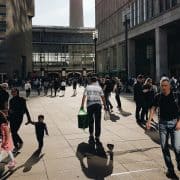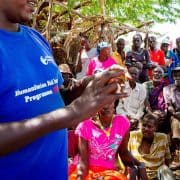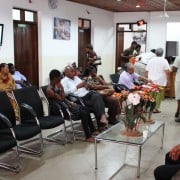|
Getting your Trinity Audio player ready...
|
By Coralie Pring, research expert at Transparency International
Published on the Global Anti-Corruption Blog
Transparency International has been running the Global Corruption Barometer (GCB) – a general population survey on corruption experience and perception – for a decade and a half now. Before moving ahead with plans for the next round of the survey, we decided to review the survey to see if we can improve it and make it more relevant to the current corruption discourse.
In particular, we wanted to know whether it would be worthwhile to add extra questions on topics like grand corruption, nepotism, revolving doors, lobbying, and so forth. To that end, we invited 25 academics and representatives from some of Transparency International’s (TI) national chapters to a workshop last October to discuss plans for improving the GCB. We initially planned to focus on what we thought would be a simple question: Should we expand the GCB survey to include questions about grand corruption and political corruption?
In fact, this question was nowhere near simple to answer and it really divided the group. (Perhaps this should have been expected when you get 25 researchers in one room!) Moreover, the discussion ended up focusing less on our initial query about whether or how to expand the GCB, and more on two more basic questions:
- Are citizen perceptions of corruption reflective of reality?
- And can information about citizen corruption perceptions still be useful even if they are not accurate?
Because these debates may be of interest to many of this blog’s readers, and because TI is still hoping to get input from a broader set of experts on these and related questions, we would like to share a brief summary of the workshop exchange on these core questions.
On the first question – whether citizen perceptions of corruption in their country (especially high-level political corruption, with which most survey respondents are unlikely to have direct experience) are useful indicators of actual corruption – there was a sharp difference of opinion among the experts who participated in the workshop.
On the one hand, there were some very vocal supporters of the idea that citizens can have direct knowledge of high-level corruption. People may see in their home town how an incredibly expensive villa was built by a politician, the cost of which clearly exceeds the modest salary paid to MPs. A politician’s family may suddenly be seen on social media taking expensive foreign holidays or shopping trips. Or they may know of a friend or family member who got a public sector job due to nepotism rather than via a competitive recruitment. (Indeed, a few of the participants insisted that citizen perceptions of grand corruption were likely more accurate than citizen self-reports of personal experience with petty corruption, given the reluctance of many citizens to answer questions about personal experience honestly.)
That said, other workshop participants expressed deep scepticism that citizen perceptions of high-level corruption – forms of corruption in which the citizens themselves do not participate or directly observe – will be very meaningful. Rather, citizen perceptions of corruption will be just that – perceptions – and those perceptions may, as some of our workshop participants insisted, be wildly inaccurate. A highly corrupt government, or example, may clamp down on the freedoms of the press or civil society, ensuring that the public are not informed. Alternatively, in a country with a free and vibrant press, and when the judicial system is doing an excellent job at convicting the corrupt, citizens may perceive corruption to be on the rise when really it was just hidden from view before.
More generally, variations in citizen perceptions of corruption may be driven more by variations in levels of cynicism, or by media coverage, or by differences in understandings of what counts as “corruption,” than by actual variations in the prevalence of particular forms of corrupt conduct across countries.
This exchange led to a second debate about whether it is still useful to ask such questions about perceptions of high-level corruption, even when knowing (or at least suspecting) that the results may not accurately reflect reality. Several of the academic researchers took the position that citizen perceptions of corruption were so unreliable – and added so little to existing measures of expert perceptions – that the GCB should focus on asking citizens about their personal experience with those forms of corruption that average citizens were most likely to encounter, especially petty bribery. (Those taking this position did suggest, though, that the GCB could be expanded to include questions on a wider range of corruption experience, including not just bribery but vote buying, absenteeism in public schools and health clinics, and the extortion of sexual gratification.)
By contrast, other academics and all of the TI chapter representatives answered the question whether it was worthwhile to ask citizens about their perceptions of high-level corruption with a resounding “yes” – even if those perceptions aren’t well-grounded in direct experience or observation. After all, perceptions drive action: people’s perceptions of political corruption or grand corruption may drive how they vote in an election, whether they would take to the street in protest, and whether they would support government reforms or a TI national campaign for law change.
TI board member (and Griffith University Professor) A.J. Brown and I will be in further discussion with stakeholders to develop an appropriate set of changes to the GCB. In these conversations, we also need to keep in mind the following questions:
- How can we write the questions so that they will be meaningful in all countries—from Azerbaijan to Greenland to Sweden?
- How can we ask the questions in a way that will minimize the risks of “social desirability bias” (the tendency of respondents to say what they think they should say, rather than what they know or believe to be the truth)?
- How can we ask the questions in a way which does not include vague, complicated, or culturally specific terms like “grand corruption” or “whistleblowing”?
- How can we design the survey so that the results can be easily communicated via the media to citizens?
This is by no means easy to do, especially when one keeps in mind—as we had to continually remind the participants in our workshop—the GCB survey can only include a very limited number of questions. (The typical completion time for each respondent must be no more than 15-20 minutes.) Care will also need to be taken in how the results are analysed and communicated. But we are certainly committed to ensuring that the GCB stays relevant for the next generation of corruption researchers and it continues to inform the debate.
We welcome any further comments or suggestions on expanding the GCB survey to ask about political corruption issues, and would like to hear about other research which has asked citizens about this via surveys in the past. If you would like to contribute your thoughts and suggestions, please include them in the comment section below, or email me directly at cpring@transparency.org.








